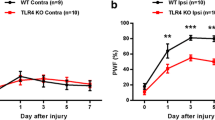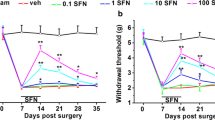Abstract
Peripheral nerve injury often leads to neuropathic pain. In the present study, we assessed the role of liver x receptor alpha (LXRα), an oxysterol regulated nuclear transcription factor that promotes reverse cholesterol transport and alternative (M2) macrophage activation, in the development of neuropathic pain. We found that compared to WT mice, in LXRα knockout mice the development of mechanical allodynia following sciatic nerve crush was accelerated and the duration was prolonged. Furthermore, the expression of M1-like macrophage marker iNOS and M1-like macrophages inducer hydrogen peroxide (H2O2) was increased, whereas expression of M2 macrophage marker arginase-1 (Arg-1) and interleukin-10 (IL-10) was reduced in the sciatic nerve of LXRα knockout mice. Moreover, peri-sciatic administration of LXRs agonist GW3965, immediately after the nerve crush, into wild type mice, suppressed the mechanical allodynia induced by crush injury. GW3965 also suppressed the expression of iNOS and production of H2O2 in the injured nerve and enhanced the expression of IL-10 and Arg-1. Importantly, peri-sciatic administration of IL-10 neutralization antibody prevented the alleviating effect of GW3965 on mechanical allodynia. Altogether, these results indicates that the lack of LXRα in the sciatic nerve results in an augmented inflammatory profile of macrophages, which ultimately speed up the development of neuropathic pain and dampen its recovery following nerve injury. Activation of LXRα by its agonist might rebalance the neuroprotective and neurotoxic macrophage phenotypes, and thus alleviate the neuropathic pain behavior.





Similar content being viewed by others
References
Bowsher D (1991) Neurogenic pain syndromes and their management. Br Med Bull 47(3):644–666
Zelcer N, Tontonoz P (2006) Liver X receptors as integrators of metabolic and inflammatory signaling. J Clin Invest 116(3):607–614
Zhu RT, Gong JP (2012) The role of neutrophil gelatinase-associated lipocalin (NGAL) in the glycolipid metabolism and inflammation. Sheng Li Ke Xue Jin Zhan 43(3):198–201
Fessler MB (2008) Liver X receptor: crosstalk node for the signaling of lipid metabolism, carbohydrate metabolism, and innate immunity. Curr Signal Transduct Ther 3(2):75–81
Joseph SB, Castrillo A, Laffitte BA, Mangelsdorf DJ, Tontonoz P (2003) Reciprocal regulation of inflammation and lipid metabolism by liver X receptors. Nat Med 9(2):213–219
Hichor M, Sundaram VK, Eid SA, Abdel-Rassoul R, Petit PX, Borderie D et al (2018) Liver X Receptor exerts a protective effect against the oxidative stress in the peripheral nerve. Sci Rep 8(1):2524
Han S, Zhuang H, Shumyak S, Wu J, Xie C, Li H et al (2018) Liver X receptor agonist therapy prevents diffuse alveolar hemorrhage in Murine Lupus by repolarizing macrophages. Front Immunol 9:135
Skaggs BJ, Hahn BH, McMahon M (2012) Accelerated atherosclerosis in patients with SLE–mechanisms and management. Nat Rev Rheumatol 8(4):214–223
Gavini CK, Bookout AL, Bonomo R, Gautron L, Lee S, Mansuy-Aubert V (2018) Liver X receptors protect dorsal root ganglia from obesity-induced endoplasmic reticulum stress and mechanical allodynia. Cell Rep. 25(2):271–277
Xu J, Feng YW, Liu L, Wang W, Zhong XX, Wei XH et al (2017) Liver X receptor alpha is involved in counteracting mechanical allodynia by inhibiting neuroinflammation in the spinal dorsal horn. Anesthesiology 127(3):534–547
Siqueira Mietto B, Kroner A, Girolami EI, Santos-Nogueira E, Zhang J, David S (2015) Role of IL-10 in resolution of inflammation and functional recovery after peripheral nerve injury. J Neurosci 35(50):16431–16442
De Santa F, Vitiello L, Torcinaro A, Ferraro E (2019) The role of metabolic remodeling in macrophage polarization and its effect on skeletal muscle regeneration. Antioxidants Redox Signal 12:1553–1598
Roszer T (2015) Understanding the mysterious M2 macrophage through activation markers and effector mechanisms. Mediators Inflamm 2015:816460
McGrath JC, Lilley E (2015) Implementing guidelines on reporting research using animals (ARRIVE etc.): new requirements for publication in BJP. Br J Pharmacol 172(13):3189–3193
Mietto BS, Jurgensen S, Alves L, Pecli C, Narciso MS, Assuncao-Miranda I et al (2013) Lack of galectin-3 speeds Wallerian degeneration by altering TLR and pro-inflammatory cytokine expressions in injured sciatic nerve. Eur J Neurosci 37(10):1682–1690
Wei XH, Yang T, Wu Q, Xin W, Wu JL, Wang YQ et al (2012) Peri-sciatic administration of recombinant rat IL-1beta induces mechanical allodynia by activation of src-family kinases in spinal microglia in rats. Exp Neurol 234(2):389–397
Chaplan SR, Bach FW, Pogrel JW, Chung JM, Yaksh TL (1994) Quantitative assessment of tactile allodynia in the rat paw. J Neurosci Methods 53(1):55–63
Xu J, Wei X, Gao F, Zhong X, Guo R, Ji Y et al (2019) NADPH oxidase 2 derived ROS contributes to LTP of C-fiber evoked field potentials in spinal dorsal horn and persistent mirror-image pain following high frequency stimulus of the sciatic nerve. Pain. https://doi.org/10.1097/j.pain.0000000000001761
Regnier M, Polizzi A, Lukowicz C, Smati S, Lasserre F, Lippi Y et al (2019) The protective role of liver X receptor (LXR) during fumonisin B1-induced hepatotoxicity. Arch Toxicol 93(2):505–517
Zheng S, Yang H, Chen Z, Zheng C, Lei C, Lei B (2015) Activation of liver X receptor protects inner retinal damage induced by N-methyl-D-aspartate. Invest Ophthalmol Vis Sci 56(2):1168–1180
Rahmati-Ahmadabad S, Shirvani H, Ghanbari-Niaki A, Rostamkhani F (2018) The effects of high-intensity interval training on reverse cholesterol transport elements: a way of cardiovascular protection against atherosclerosis. Life Sci 209:377–382
Yang M, Wang R, Sun J, Yu K, Chen B, Xu L et al (2015) The liver X receptor agonist TO901317 protects mice against cisplatin-induced kidney injury. Exp Biol Med 240(12):1717–1727
Andersson S, Gustafsson N, Warner M, Gustafsson JA (2005) Inactivation of liver X receptor beta leads to adult-onset motor neuron degeneration in male mice. Proc Natl Acad Sci USA 102(10):3857–3862
Meffre D, Shackleford G, Hichor M, Gorgievski V, Tzavara ET, Trousson A et al (2015) Liver X receptors alpha and beta promote myelination and remyelination in the cerebellum. Proc Natl Acad Sci USA 112(24):7587–7592
Venkateswaran A, Laffitte BA, Joseph SB, Mak PA, Wilpitz DC, Edwards PA et al (2000) Control of cellular cholesterol efflux by the nuclear oxysterol receptor LXR alpha. Proc Natl Acad Sci USA 97(22):12097–12102
Repa JJ, Turley SD, Lobaccaro JA, Medina J, Li L, Lustig K et al (2000) Regulation of absorption and ABC1-mediated efflux of cholesterol by RXR heterodimers. Science 289(5484):1524–1529
Yu XH, Qian K, Jiang N, Zheng XL, Cayabyab FS, Tang CK (2014) ABCG5/ABCG8 in cholesterol excretion and atherosclerosis. Clin Chim Acta 428:82–88
Repa JJ, Berge KE, Pomajzl C, Richardson JA, Hobbs H, Mangelsdorf DJ (2002) Regulation of ATP-binding cassette sterol transporters ABCG5 and ABCG8 by the liver X receptors alpha and beta. J Biol Chem 277(21):18793–18800
Zelcer N, Hong C, Boyadjian R, Tontonoz P (2009) LXR regulates cholesterol uptake through Idol-dependent ubiquitination of the LDL receptor. Science 325(5936):100–104
Krisanova N, Sivko R, Kasatkina L (1822) Borisova T (2012) Neuroprotection by lowering cholesterol: a decrease in membrane cholesterol content reduces transporter-mediated glutamate release from brain nerve terminals. Biochem Biophys Acta 10:1553–1561
Zhu HQ, Xu J, Shen KF, Pang RP, Wei XH, Liu XG (2015) Bulleyaconitine A depresses neuropathic pain and potentiation at C-fiber synapses in spinal dorsal horn induced by paclitaxel in rats. Exp Neurol 273:263–272
Deng M, Chen SR, Pan HL (2019) Presynaptic NMDA receptors control nociceptive transmission at the spinal cord level in neuropathic pain. Cell Mol Life Sci CMLS 76(10):1889–1899
Huang W, Ghisletti S, Saijo K, Gandhi M, Aouadi M, Tesz GJ et al (2011) Coronin 2A mediates actin-dependent de-repression of inflammatory response genes. Nature 470(7334):414–418
Schulman IG (2017) Liver X receptors link lipid metabolism and inflammation. FEBS Lett 591(19):2978–2991
Pradel LC, Mitchell AJ, Zarubica A, Dufort L, Chasson L, Naquet P et al (2009) ATP-binding cassette transporter hallmarks tissue macrophages and modulates cytokine-triggered polarization programs. Eur J Immunol 39(8):2270–2280
Li P, Spann NJ, Kaikkonen MU, Lu M, Oh DY, Fox JN et al (2013) NCoR repression of LXRs restricts macrophage biosynthesis of insulin-sensitizing omega 3 fatty acids. Cell 155(1):200–214
Kim SY, Lim EJ, Yoon YS, Ahn YH, Park EM, Kim HS et al (2016) Liver X receptor and STAT1 cooperate downstream of Gas6/Mer to induce anti-inflammatory arginase 2 expression in macrophages. Sci Rep 6:29673
Marathe C, Bradley MN, Hong C, Lopez F, Ruiz de Galarreta CM, Tontonoz P et al (2006) The arginase II gene is an anti-inflammatory target of liver X receptor in macrophages. J Biol Chem 281(43):32197–32206
Rendra E, Riabov V, Mossel DM, Sevastyanova T, Harmsen MC, Kzhyshkowska J (2019) Reactive oxygen species (ROS) in macrophage activation and function in diabetes. Immunobiology 224(2):242–253
Kohchi C, Inagawa H, Nishizawa T, Soma G (2009) ROS and innate immunity. Anticancer Res 29(3):817–821
Padgett LE, Burg AR, Lei W, Tse HM (2015) Loss of NADPH oxidase-derived superoxide skews macrophage phenotypes to delay type 1 diabetes. Diabetes 64(3):937–946
Rani V, Deep G, Singh RK, Palle K, Yadav UC (2006) Oxidative stress and metabolic disorders: Pathogenesis and therapeutic strategies. Life Sci 148:183–193
Acknowledgements
This work was supported by grants from the National Natural Science Foundation of China (Beijing, People’s Republic of China. Nos. 81870969, 81471250); Nature Science Foundation of Guangdong Province of China (Guangzhou, People’s Republic of China, No. 2019A1515011855).
Author information
Authors and Affiliations
Corresponding authors
Ethics declarations
Conflict of interest
The authors have no conflicts of interest to declare.
Additional information
Publisher's Note
Springer Nature remains neutral with regard to jurisdictional claims in published maps and institutional affiliations.
Rights and permissions
About this article
Cite this article
Mao, Z., Huang, R., Xu, J. et al. Liver X Receptor α in Sciatic Nerve Exerts an Alleviating Effect on Neuropathic Pain Behaviors Induced by Crush Injury. Neurochem Res 46, 358–366 (2021). https://doi.org/10.1007/s11064-020-03171-3
Received:
Revised:
Accepted:
Published:
Issue Date:
DOI: https://doi.org/10.1007/s11064-020-03171-3




